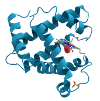Genetic and Evolutionary Computation Conference (GECCO 2015)
Madrid, Spain
July 11-15, 2015
Abstract
Our ongoing work focuses on improvments to the exploration behaviour of heuristic search methods in fragment-assembly methods for protein structure prediction. Analysing and improving exploration in fragment-assembly can be difficult due to the complexity of measuring diversity between decoys in a meaningful manner. Here, we define a set of local and global features of decoy structures generated by Rosetta, and we use Machine Learning to explore the extent to which these are predictive of the final prediction results achieved by individual runs. The aim is to identify those feature subsets that show a significant correlation with final prediction outcome, and identify when they become fixed during the search. It is thought that such features may help in the formulation of new diversity measures that can be utilized in the context of explicit diversity mechanisms such as crowding, external archives etc. The time of fixture can help in deciding at what stage of the search the implemention of diversity mechanisms may be the most relevant.
